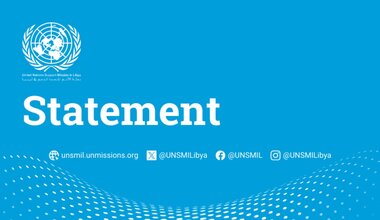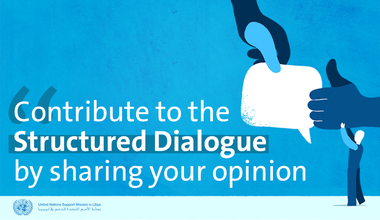Libya Human Rights Report on Civilian Casualties - May 2017
Tunis, 1 June 2017 – From 1 May to 31 May 2017, the United Nations Support Mission in Libya (UNSMIL) documented 68 civilian casualties - 18 deaths and 50 injuries – during the conduct of hostilities across Libya. The total civilian casualty figure for May is the highest for any month so far in 2017. Victims included 13 men killed and 20 injured, 5 children killed and 4 injured and 5 women injured. UNSMIL was unable to determine the age of another 20 injured males and 1 injured female.
Civilian Casualties
The majority of civilian casualties were caused by a Vehicle Borne Improvised Explosive Device (VBIED), (5 deaths and 20 injuries), followed by gunfire (9 deaths and 6 injuries), and airstrikes (1 death and 6 injuries). Another 3 civilians were killed and 2 injured when a tank exploded after being set on fire. The exact cause of 16 further injuries is unknown.
UNSMIL documented 5 deaths and 20 injuries in Salouq, 4 deaths and 7 injuries in Tripoli, 15 injuries in Benghazi, 6 deaths in Brak al-Shatti, 1 death and 6 injuries in Hun, 1 death and 1 injury in al-Zawiya and 1 death and 1 injury in Bani Walid.
The civilian casualties included 14 injured (9 men, 4 women and another female whose age is unknown), who sustained wounds from shrapnel and flying debris in an attack on the Shebna-Sirty neighborhood in Benghazi on 3 May. On 19 May, 2 men and 2 boys were killed, and a further 20 males were injured in the city of Salouq in a VBIED attack in front of the Bilal Ben Rebah mosque, as worshippers were leaving Friday prayers. Another boy succumbed to his injuries several days later.
On 18 May, 95 bodies, as well as a few injured, were brought to a hospital in southern Libya as a result of a coordinated attack by the Misratan Third Force, backed by Benghazi Defense Brigades (BDB) and other allies, against the Brak al-Shatii airbase, controlled by the Libyan National Army (LNA) 12th Brigade. The majority were in military uniform and were fighters either stationed at the airbase or in transit to another base. At least three civilians were shot dead as they were driving near the Brak al-Shatti airbase. Another three civilian workers were shot dead inside the airbase. The exact number of other civilian casualties remains unconfirmed. On 19 May, the Presidential Council condemned the attack and established a committee to investigate the violence. In apparent retaliation, airstrikes were carried out on several targets in Jufra municipality, leading to the death of 1 Nigerien migrant and the injury of 6 other men in the town of Hun and its outskirts on 20 and 22 May.
On 26 May, heavy armed clashes in several southern Tripoli neighborhoods between the al-Soumoud armed group and allies including the al-Burki armed group, on one hand, and the Tripoli Revolutionary Brigades (TRB), the Central Security Abu Salim and allies, on the other, led to at least 44 fatalities and over 100 injuries. A 12 year old boy and 2 civilian men were killed, when a tank exploded in the area of Mashrou’ al-Hadba at around 6:30pm on 26 May. Another man sustained fatal injuries in crossfire, while at home in the area of Zuhur (also known as Hay al-Akwakh). At least 4 civilian men and 2 boys were injured in the violence that engulfed Tripoli on 26 May. For instance, a Tawerghan man was shot in the back, while walking in the Fallah-2 IDP camp, in the vicinity of the clashes. UNSMIL has been unable to ascertain the civilian status of the other casualties on 26 May.
Civilian Facilities
On 26 May, the Safaa Hospital in the al-Hadba al-Khadra neighborhood of Tripoli was hit by unspecified projectiles during fighting between armed groups (see above), causing some material damage. Patients were evacuated to the Red Crescent Clinic in central Tripoli.
Attribution
Anti-LNA forces who attacked the Brak al-Shatti airbase on 18 May are believed to be responsible for civilian casualties. Reports indicated that the LNA or their allies carried out the airstrikes that caused civilian casualties in Hun. The al-Burki armed group was reported to have set a tank on fire in the area of Mashrou’ al-Hadba on 26 May, which then exploded and led to civilian casualties. Fighters with the so-called Islamic State in Syria and the Levant (ISIL) are responsible for 1 death and 1 injury in Bani Walid. UNSMIL was unable to determine with certainty which parties to the conflict caused the other civilian casualties in May.
Other Casualties
During May, two videos emerged on social media depicting three apparent summary executions in eastern Libya. In one video, a Benghazi commander of the Special Forces is seen shooting dead a man, identified by the perpetrator as an Algerian fighter with the so-called ISIL. The same commander appeared in earlier videos of summary executions (see March 2017 Human Rights Report on Civilian Casualties). In the second video, two men in face masks are seen shooting dead two victims kneeling on the ground. A third man wearing black – who appears to give orders– is also seen in the video. The two victims are believed to have been captured after escaping Block 12 in the Benghazi neighborhood of Ganfouda on 18 March 2017, then under the control of the Benghazi Revolutionaries Shura Council (BRSC) and besieged by the LNA.
In the aftermath of the attack on the Brak al-Shatti airbase on 18 May (see above), a number of bodies were brought to a local hospital bearing single gunshot wounds to the head, raising concerns that they had been shot dead after capture. Some bodies were reported to have been found with their hands bound.
On 18 May, a recent returnee, displaced since the 2011 armed conflict, was shot dead near his Tomina home, in the outskirts of Misrata, following an earlier dispute with a man believed to be a member of the Tomina-based Martyr Omar Issa armed group.
On 20 May, the body of a male bearing a gunshot wound was brought to a Tripoli hospital. The victim’s hands and legs were bound with metal chains. He was reportedly abducted some 40 days earlier by armed groups in Wershefana. On 21 May, the body of a 24 year old man was brought to a Tripoli hospital bearing torture marks.
At around 9:30pm on 26 May, a Tripoli hospital received six bodies of guards from the al-Hadba Correction and Rehabilitation Institution. Five bore similar gunshot wounds to the back of the head, raising concerns of possible summary execution. Some hours earlier, TRB gained control of the facility previously headed by Khaled al-Sherif, a former member of the Libyan Islamic Fighting Group (LIFG). Senior figures in Mu’ammar Qadhafi’s regime were among the some 160 inmates held at the facility, including former director of Military Intelligence Abdullah al-Senussi, former head of External Security, Abu Zeid Dorda, and Saadi al-Qhadafi, son of the former ruler. Unconfirmed reports indicated that at the time of writing inmates were held at the al-Na’am Farm under the control of the Commander of the TRB.
Note
The figures for civilian casualties set out above only include persons killed or injured in the course of hostilities and who were not directly participating in the hostilities. The figures do not include those casualties that are not a direct result of hostilities, for example executions after capture, torture or abductions, or casualties caused as an indirect consequence of hostilities. The figures are based on information UNSMIL has gathered and cross-checked from a broad range of sources in Libya, including human rights defenders, civil society, current and former officials, employees of local governments, community leaders and members, witnesses, others directly affected and media reports. In order to assess the credibility of information obtained, where possible, UNSMIL reviewed documentary information, including medical records, forensic reports and photographic evidence.
The figures are only those that UNSMIL was able to document in the reporting period. They are not likely to be complete and may change as new information emerges about incidents involving civilian casualties that took place during this period.
Similarly, while UNSMIL has systematically tried to ensure that the cases it documented are based on credible information, further verification would be required to attain a higher standard of proof. Due to the security situation, UNSMIL has not been able to carry out direct site visits to all relevant locations in Libya to obtain information. Fear of reprisals against sources further hamper information gathering.
While not all actions leading to civilian casualties breach international humanitarian law, UNSMIL reminds all parties to the conflict that they are under an obligation to target only military objectives. Direct attacks on civilians as well as indiscriminate attacks – which do not distinguish between civilians and fighters – are prohibited. Attacks that are expected to cause incidental loss of civilian life, injury to civilians and damage to civilian objects excessive to the anticipated concrete and direct military advantage are also prohibited. Such attacks amount to war crimes that can be prosecuted by the International Criminal Court.
In order to ensure greater protection of the civilian population and essential infrastructure, all parties engaged in fighting in Libya must cease the use of mortars and other indirect weapons and imprecise aerial bombardments in civilian-populated areas, and not place fighters or other military objectives in populated areas. All executions of captives must cease and all those captured including fighters must be treated humanely in all circumstances. Murdering or torturing captives is also a war crime, regardless of what the captive may be accused of.
 United Nations Peacekeeping
United Nations Peacekeeping UN
UN









